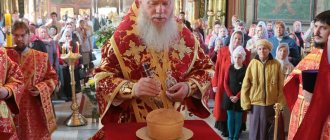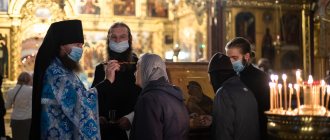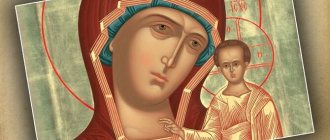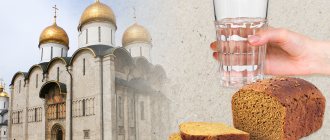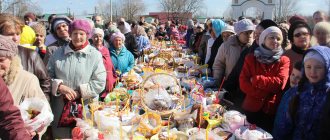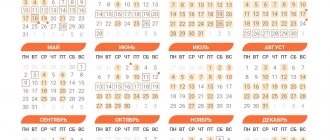Even if you don’t think about Orthodox traditions and holidays, but still celebrate the most famous church holidays, this post is for you. This year there have already been big holidays, these are Christmas, Epiphany, Candlemas. But the most famous dates await us. The end of February will be marked by the onset of Maslenitsa, it will be celebrated from February 28 to March 6, this week the Orthodox are preparing for Lent, which will begin on March 7. This week people bake pancakes with various fillings and visit relatives and friends. We will touch on this tradition much later, but now I want to tell you what holidays await us throughout the year, how and when to fast, when to remember loved ones, and we will also consider other questions that ordinary people most often ask.
weeks in which there is no fast on Wednesday and Friday
January 7 - 18 - Christmastide
February 14 - 19 ‒ The Publican and the Pharisee
February 28 - March 6 ‒ Maslenitsa
April 25 - 30 ‒ Easter week
June 13 - 19 - Trinity Week
calendar schedule of Orthodox holidays
Church Orthodox calendar
Church Orthodox holidays are divided into great, medium and small. The great ones include Easter, the Twelves and the Non-Twelfths. On these days, services in churches are held with particular solemnity.
Easter
Easter (the full church name is the Holy Resurrection of Christ) is the most important and brightest event in the Christian church calendar. The date of the holiday is unique for each year, determined according to the solar-lunar calendar and falls between April 4 and May 8. Easter commemorates the resurrection of Jesus Christ after the crucifixion. On this day, it is customary to attend services, bless Easter cakes and colored eggs in churches, set a festive table, and organize festivities. People greet each other with the words: “Christ is risen!”, to which they are supposed to respond: “Truly he is risen!”
Twelfth holidays
The Twelfth Holidays are the 12 most important holidays of the Orthodox calendar, dedicated to the events of the earthly life of Jesus Christ and the Mother of God. They are divided into two categories: non-transient and transitory.
Twelfth Immovable Holidays
The twelfth immovable holidays have a fixed date, falling on the same date every year.
Nativity of Christ - January 7 The holiday was established in honor of the birth of Jesus Christ. On this day, it is customary to attend services, set the festive table, go from house to house and sing carols. People greet each other with the words: “Christ is born!”, to which they are supposed to respond: “We praise Him!” The holiday is preceded by a 40-day Nativity fast.
Epiphany (Holy Epiphany) - January 19 The holiday was established in honor of the baptism of Jesus Christ in the Jordan River by John the Baptist. On this day, it is customary to bless water in churches and swim in an ice hole.
Presentation of the Lord - February 15 The holiday was established in memory of the meeting in the Jerusalem Temple of Simeon the God-Receiver with little Jesus during the rite of dedication to God. The meeting took place on the 40th day after the birth of Jesus. On this day it is customary to pray, go to church, and bless candles.
Annunciation of the Blessed Virgin Mary - April 7 The holiday is dedicated to the announcement by Archangel Gabriel to the Virgin Mary of the conception and future birth of the Son of God. On this day, it is customary to attend services, consecrate bread in churches, give alms, and engage in charity work.
Transfiguration of the Lord - August 19 The holiday is dedicated to the memories of the Divine Transfiguration of Jesus before the disciples during prayer on Mount Tabor. On this day, it is customary to bless apples, pears, and grapes in the church, and to honor the memory of deceased relatives.
Dormition of the Blessed Virgin Mary - August 28 The holiday is dedicated to the memory of the Dormition (death) of the Mother of God. On this day, believers go to church, pray to the Most Holy Theotokos, bless bread, and give alms. The holiday is preceded by the Assumption Fast.
Nativity of the Blessed Virgin Mary - September 21 The holiday was established in honor of the birth of the Virgin Mary - the mother of Jesus Christ. On this day it is customary to attend church, pray to the Blessed Virgin Mary, and do charity work.
Exaltation of the Holy Cross - September 27 The full name of the holiday is the Exaltation of the Honest and Life-Giving Cross of the Lord. It was erected in honor of the discovery of the Cross on which Jesus was crucified in Jerusalem near Mount Golgotha. On this day, it is customary to observe strict fasting and pray for your health and the health of loved ones.
Entry into the Temple of the Blessed Virgin Mary - December 4 The holiday is dedicated to the introduction of little Mary - the mother of Jesus Christ - into the Jerusalem Temple for dedication to God. On this day, a solemn service is held in churches, parishioners pray to the Virgin Mary.
Twelfth Moving Holidays
The twelfth moving holidays have a unique date for each year, which depends on the date of Easter and moves with it.
Palm Sunday (Entry of the Lord into Jerusalem) The holiday is celebrated a week before Easter. Dedicated to the solemn appearance of Jesus Christ in Jerusalem on the eve of His martyrdom and death. On this day, it is customary to bless the willow in the church, to whip family members with branches, saying: “I don’t hit, it’s the willow that hits!” or “Willow whip, beat me to tears!”
Ascension of the Lord The full name of the holiday is the Ascension of the Lord God and our Savior Jesus Christ. Celebrated on the 40th day after Easter. The holiday commemorates the ascension of Jesus Christ into heaven. On this day, it is customary to attend services in churches, pray, and give alms.
Holy Trinity Day (Pentecost) Celebrated on the 50th day after Easter. The holiday was established in honor of the descent of the Holy Spirit on the apostles and the Virgin Mary. On Trinity, it is customary to attend a solemn service in the church, decorate churches and houses with tree branches, cover the floor with fresh grass, have a festive dinner, and organize festivities and fairs.
Non-Twelfth Holidays
Non-twelfth holidays - 5 great holidays of the Orthodox Church, dedicated to the birth and death of John the Baptist - the baptizer of Jesus Christ, the apostles Peter and Paul, the appearance of the Mother of God, the circumcision of the Lord.
Circumcision of the Lord - January 14 The holiday was established in remembrance of the Jewish rite of circumcision performed on the baby Jesus. On this day, festive services are held in churches, people go home, sing sowing songs and wish the owners well and prosperity.
Nativity of John the Baptist - July 7 The full name of the holiday is the Nativity of the honest, glorious Prophet, Forerunner and Baptist of the Lord John. Dedicated to the birth of John the Baptist - the baptizer of Jesus Christ. On this day, people attend services and bless water, herbs and flowers in the church.
Holy Apostles Peter and Paul - July 12 The holiday is dedicated to the remembrance of the transfer of the relics of the holy apostles Peter and Paul. On this day, fishermen pray for successful fishing, fairs and celebrations are held.
Beheading of John the Baptist - September 11 The holiday is dedicated to the memory of the martyrdom of John the Baptist - the baptizer of Jesus Christ. On this day, it is customary to attend services and observe strict fasting.
Protection of the Most Holy Theotokos - October 14 The holiday was established in honor of the appearance of the Virgin Mary to Saint Andrew the Fool. On this day, it is customary to visit churches and pray to the Most Holy Theotokos for health, intercession, and a happy family life.
Middle and small Orthodox holidays are distinguished by less solemnity of worship.
Everyday holidays are not holidays in their essence. These are the days of remembrance of saints.
Orthodox fasts
– periods of abstinence from food of animal origin. By duration, posts are divided into multi-day and one-day ones. There are 4 multi-day and 3 one-day fasts per year. Also, every Wednesday and Friday are fast days (there is no fasting on these days during continuous weeks). Fasts vary in severity, up to complete abstinence from food.
Solid weeks
– weeks in which there is no fasting on Wednesday and Friday. There are 5 such weeks in a year.
All Souls Days
- days of general remembrance of dead Christians. There are 8 such days in a year.
Ascension of the Lord
Forty days after Easter, Orthodox Christians celebrate the Ascension of the Lord. This is the twelfth holiday, the date of which varies depending on the celebration of Easter, but always falls on Thursday. Such holidays are called mobile, or moving. There are three moving twelve holidays in total: the Entry of the Lord into Jerusalem (celebrated on the sixth Sunday of Lent), the Ascension of the Lord (celebrated on the fortieth day after Easter), Trinity Day, or Pentecost (celebrated on the fiftieth day after Easter).
The Feast of the Ascension of the Lord reminds Christians of how, on the fortieth day after His resurrection, Jesus Christ ascended to heaven from the Mount of Olives. The event of the Ascension is described in detail in the Gospel of Luke (Luke 24:50–51) and the Acts of the Holy Apostles (Acts 1:9-11). According to the Holy Scriptures, after His resurrection, Jesus Christ repeatedly appeared to his disciples so that they would be convinced of the truth of his bodily resurrection, strengthened in faith and become ready to receive the promised Holy Spirit. Finally, commanding not to leave Jerusalem and to wait for what was promised from the Father, the Savior led the disciples out of the city to Bethany, to Mount Olivet. There, raising his hands, the Lord blessed them, and then ascended to heaven.
The Feast of the Ascension of the Lord falls at the end of spring - beginning of summer. The following proverbs have developed among the people about this holiday: “Spring asks for the Ascension to heaven, ascends to rest in a bright paradise,” “And spring in Rus' would be glad to last forever, and Ascension Day comes - it will crow like a cuckoo, it will fill with a nightingale, and by summer it will be in your bosom.” will clean up."
What kind of dishes are prepared? From the Ascension until the Transfiguration, until the consecration of the new harvest of fruits, apples are not served at meals. In different regions of Russia, they prepared their own special dishes for the Ascension: in some they baked pancakes - “for Christ’s path,” and in some they prepared baked goods in the shape of a ladder, “to make it easier for the Savior to ascend to heaven.”
The week following the Ascension was called Green Christmastide. By this week, plowing and sowing had ended, and the harvest had not yet begun; folk festivities were held. Saturday of this week is Trinity Parents' Saturday , the day of remembrance of all Orthodox Christians who have died from time to time. The Sunday following parental Saturday is the moving twelfth holiday, Trinity Day, or Pentecost.
The Patriarchal calendar for 2022 has been published
The publishing house of the Moscow Patriarchate has released the Patriarchal Calendar for 2021 - the official calendar and liturgical, as well as reference publication of the Russian Orthodox Church.
The Patriarchal Calendar continues the tradition of a complete official calendar-reference book for the upcoming liturgical year and the structure of the Russian Orthodox Church. The unique edition includes the traditional complete monthly book with detailed liturgical notes, troparions and kontakia, as well as fragments of sermons by His Holiness Patriarch Kirill of Moscow and All Rus' for each day of the church year. The calendar contains troparia and kontakia of those holidays or saints, the performance of services for which is provided for by the Liturgical Instructions issued by the Publishing House of the Moscow Patriarchate. The liturgical features of the coming year are revealed in the liturgical notes.
The Patriarchal calendar for 2022 reflects a number of church memorable dates and anniversaries: the 1000th anniversary of the repose of St. Simeon the New Theologian, the 800th anniversary of the birth of the Holy Blessed Grand Duke Alexander Nevsky (the introductory article of the calendar is dedicated to the event), the 500th anniversary of the miraculous the salvation of Moscow from the invasion of the Crimean Khan Makhmet-Girey through the intercession of the Mother of God through Her “Vladimir” icon, the 300th anniversary of the bringing to St. Petersburg of the revered copy of the Kazan Icon of the Mother of God, the 75th anniversary of the resumption of services in the Trinity-Sergius Lavra. Also, 2022 marks the 75th anniversary of the birth and 45 years of the episcopal consecration of His Holiness Patriarch Kirill of Moscow and All Rus'.
Special sections of the calendar provide background information about synodal and general church institutions, dioceses and episcopates of the Moscow Patriarchate, foreign parishes of the Russian Orthodox Church, theological educational institutions and Orthodox educational institutions.
The calendar contains a large number of color illustrations in all sections: icons for anniversaries, photographic materials covering events in church life and the ministry of the Primate of the Russian Orthodox Church; photographs of the episcopate are posted in the corresponding section.
The Patriarchal Calendar for 2022 also includes an additional information sheet regarding personnel decisions made at the meeting of the Holy Synod of the Russian Orthodox Church held on August 25, 2022.
Publishing house of the Moscow Patriarchate
Share:
- Click to share on Facebook (Opens in new window)
- Share on Twitter (Opens in new window)
- Send link to Odnoklassniki (Opens in new window)
- Send link on VKontakte (Opens in new window)
- Send link to My World (Opens in new window)
- Click to share on Google+ (Opens in new window)
Spas on Ubrus
On August 29, after the end of the Dormition Fast, the third Savior is celebrated - the Savior on Ubrus. It originates in 944. This holiday is connected with such a story. Even during the earthly life of Christ, the Edessa king Abgar was struck by a terrible disease - leprosy. There was no cure for this disease. And so King Abgar heard about the miraculous healings performed by Christ, and believed that Christ was truly the Son of God. Then Abgar wrote a letter to Christ asking for healing. When the disciples conveyed the king’s request to Christ, the Lord washed His face, wiped it with an ubrus (canvas towel), and His Divine Face was imprinted on the canvas. This obrus was delivered to King Abgar in Edessa, and he, touching it, received healing. Therefore, the third Spas is called Kholshchov. And they began to call it Nut and Bread because on this day they also consecrated the new harvest of bread and nuts.
What dishes are prepared? The Assumption Fast is distinguished by an abundance of vegetables and fruits from the new harvest, therefore, despite its severity, the Russian people have developed the following saying: “Petrovka is a hunger strike, Spasovka is a gourmet.” Starting from August 19, apples and a variety of Lenten dishes made from them appear on the Lenten table: baked apples, apple paste, apple juice and many others.
In the first photo above: Ostashkov. Nilo-Stolbenskaya desert
Posts 2022
The purpose of fasting is to cleanse the soul from sinful thoughts, liberate the spirit, cultivate and strengthen humility and other Christian virtues. During fasting, you must not only refuse inappropriate food, but also keep your thoughts pure and not commit bad deeds.
Multi-day
The longest and most important fast for believers before Easter is called the Great Fast. It lasts 40 days, which is exactly how long Christ himself fasted in the desert. Fasting is defined in order to remember the torment of the Son of God before death, to repent before the bright holiday of Easter.
Lent 2022 – March 15-May 1.
Other 2022 posts:
- Petrov - from June 28 to July 11;
- Uspensky - from August 14 to 27;
- Rozhdestvensky - from November 28 to January 6.
By abstaining from food for many days, Orthodox Christians celebrate respect and love for Christ and the Mother of God. Apostolic, or Petrovsky, fast prepares believers for the celebration of the day of the holy apostles Peter and Paul.
One-day
The Orthodox Church prescribes fasting every Wednesday and Friday. Friday is the day on which the Savior accepted torment and death. On Wednesday, one of Christ’s disciples, Judas, gave Jesus up to suffer and betrayed the Teacher.
One-day posts 2022:
- Wednesday and Friday weekly (except for continuous weeks);
- Christmas Eve for Epiphany - January 18;
- Beheading of John the Baptist - September 11;
- Exaltation of the Holy Cross - September 27.
Each fast imposes certain restrictions on food consumption, but the main thing is to remember the meaning of fasting, repent and pray.
The church calendar helps Orthodox Christians prepare for important holidays and organize fasts correctly. Before the celebrations, you need to read Scripture, understand the spirit and meaning of church services, remember the events that every Christian should comprehend and honor.
